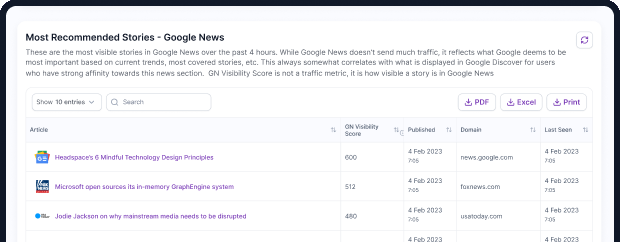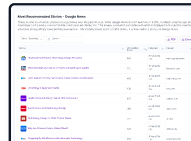The NewzDash 2025 Study: How Google’s AI Overviews Are Impacting News Visibility in Search

Google’s AI Overviews (AIO) are quietly reshaping the news ecosystem.
Instead of sending users to publishers via Top Stories or organic links, Google is increasingly generating its own summaries — powered by AI — and placing them prominently in search results. These AI Overviews often appear above Top Stories, reduce the need to click through, and shift visibility away from the publishers who originally created the content.
This isn’t just a UI update. It’s a fundamental change in how information is surfaced, attributed, and consumed in news-related search queries.
For news publishers, the stakes are high. Visibility in Top Stories is no longer enough. To succeed in this new environment, publishers must ask:
- Is this query triggering an AI Overview?
- Am I being cited or featured in it?
- What content is shaping the AI’s summary?
That’s why we built something new at NewzDash — a Real-time AI Overview News Tracker designed specifically to answer those questions.
NewzDash Now Tracks AI Overview Visibility
Traditional SEO tools were built for evergreen keywords — not for the fast-moving world of news. They track static sets of terms updated every few days or weeks. But news doesn’t work like that. Trends shift by the hour, and visibility can rise and vanish in a matter of minutes.
That’s why NewzDash has taken a major leap forward; We now track AI Overview (AIO) visibility across trending news queries in real time — every 15 minutes.
Here’s what this means for publishers:
- Know which trending queries are triggering AI Overviews — and when.
- See whether your site is being cited or featured in those AI answers.
- Measure visibility and presence inside AIOs, not just Top Stories or organic listings.
- Identify the top influencing articles that shaped the AI-generated response — so you can reverse-engineer and optimize accordingly.
This innovation builds on our proprietary real-time trend engine, which already estimates search interest for each news trend. Now, we’re extending that visibility into the AI layer — helping you understand not just what’s trending, but whether you’re visible where it matters most.
Unlike traditional SEO platforms built for evergreen content, NewzDash is purpose-built for real-time news SEO — and now, for AI-generated visibility. In an era where AI determines what gets seen, we give publishers the tools to ensure they’re not left out of the story.
![]()
The Rise of AI Overviews in News Search
AI Overviews are no longer experimental — they’re becoming a fundamental part of how Google surfaces information, including for news-related queries. And while most existing studies focus on evergreen keywords, this is the first report backed by a tool built specifically to track AI Overview visibility across trending news queries in real time.
Unlike static keyword sets used by traditional SEO platforms, NewzDash analyzes live, trending news topics updated every 15 minutes — providing a more accurate view of how AI is impacting the fast-paced news ecosystem.
Our findings show that while AI Overview visibility for news queries is still relatively limited, it’s growing — and it’s already shifting traffic and visibility patterns.
Key Findings from NewzDash:
- In the U.S., 3.47% of trending news queries now trigger AI Overviews.
- That means for every 100 trending or viral queries, more than 3 are answered by AI — bypassing both Top Stories and organic listings.
- This is consistent with our earlier study (3.9%), confirming stable AIO presence in the U.S. news SERPs.
Even small percentages represent major disruption. Thousands of trending queries every week are now being intercepted by AI-generated answers. Without visibility into this shift, news publishers risk becoming invisible — not because their content isn’t ranking, but because AI is summarizing it instead.
Previous Studies on AI Overview Visibility Based on Evergreen Keywords:
- Semrush report showing a rise from 6.49% of queries in January 2025 to 13.14% in March 2025.
- Other studies report different numbers, such as 29.9% of keywords triggering AI Overviews in a Search Engine Journal study.
In the U.S., 3.47% of trending news queries are now being answered by AI Overviews. This means that for every 100 trending news queries, more than 3 are answered by AI — not just publishers.
Other top-impacted regions include Australia (3.48%), Mexico (3.13%), and Japan (2.25%). European markets like the UK (1.30%) and Germany (0.95%) show lower, but still notable, AIO penetration.
![]()
AI Overviews by News Section: Not All Categories Are Treated Equally
AI Overviews are not being applied uniformly across all news topics. In fact, the likelihood of a news query triggering an AIO varies significantly by section — and understanding where they appear most (and least) is crucial for any newsroom adapting to this shift.
Based on NewzDash’s real-time tracking, here’s how AI Overviews currently impact different U.S. news categories:
- High-AIO Sections
- Health — 17.32% of health-related news queries trigger an AI Overview.
- Technology — 6.59%
- Science — 4.44%
- These high percentages reflect Google’s comfort with summarizing topics that are evergreen, fact-based, and less dependent on real-time reporting. It also suggests a higher likelihood of AI Overviews replacing news results in categories where factual accuracy, structured content, and consistent interest are present.
- Mid-AIO Sections
- Business — 2.19%
- Low-AIO Sections
- National News — 0.86%
- Top Trends — 0.69%
- Sports — 0.50%
- World News — 0.31%
- Entertainment — 0.20%
- In these categories, Google appears more reluctant to inject AI summaries — likely due to the speed, nuance, and frequent updates required. For example, sports and entertainment are fast-moving and emotional, making it risky (and often ineffective) for AI to provide static answers.
![]()
These patterns suggest that AI Overviews are being selectively deployed:
- Favoring informational, evergreen, and entity-rich topics (like health or science).
- Avoiding categories where timeliness, sentiment, or frequent updates are critical.
For newsrooms, this means tailoring strategies by section:
- In high-AIO categories, optimize for citation and influence.
- In low-AIO sections, maintain focus on speed, freshness, and breaking visibility.
What This Means for Publishers
- These patterns suggest that AI Overviews are being selectively deployed:
- Favoring informational, evergreen, and entity-rich topics (like health or science).
- Avoiding categories where timeliness, sentiment, or frequent updates are critical.
- For newsrooms, this means tailoring strategies by section:
- In high-AIO categories, optimize for citation and influence.
- In low-AIO sections, maintain focus on speed, freshness, and breaking visibility.
What Types of News Queries Trigger AI Overviews — and Why
AI Overviews don’t appear randomly — they follow consistent, detectable patterns. Based on real-time analysis of thousands of trending news queries, NewzDash has identified key characteristics that significantly increase the likelihood of AIO triggering in Google Search.
A Common Symptom: Top Stories Lower in the SERP
In most cases where AI Overviews appear for a news query, we observe that the Top Stories box is either missing or pushed down — often appearing mid-page or near the bottom of the search results.
While this isn’t a direct trigger, it’s a strong signal that Google is deemphasizing Top Stories in favor of an AI-generated response. This typically correlates with:
- Low search interest,
- Ambiguous user intent,
- Or minimal news coverage around the topic.
In other words, when Google isn't confident enough in the freshness, specificity, or coverage of available news, AIO often steps in.
![]()
Six Signals That Increase the Likelihood of AI Overviews
- Low Search Volume but Still Newsworthy
- Example: “US Space Force”
- These queries may not reach mass awareness, but they’re timely and relevant.
- When there’s little coverage or competition, AI Overviews often step in to fill the gap.
- Broad Queries with No Specific Qualifier
- Example: “Chicago”, “PAG”
- These lack clear intent (e.g., “Chicago shooting” vs. just “Chicago”).
- Google interprets them as needing contextual framing — leading to a generated summary from AI.

- Entity-Only Queries (Without Modifiers)
- Examples: “Ryder Cup”, “Savannah Bananas”, “James Webb Space Telescope”
- These are entity-rich, but vague. They could mean latest news, background info, or stats.
- AIO responds by building a topical overview — often featuring a mix of historical, event-based, and factual info
.
- Post-Event Search Decline (6–9 Hours Later)
- Example: “Pacers vs Knicks”
- During the peak of an event, Top Stories dominate.
- But as interest wanes, AIO often replaces Top Stories — summarizing outcomes, key moments, or aftermath.
- Local News Topics that are Evergreen, Medical, or Broad:
- Examples: “Measles cases Texas Dallas”, “Boston Home Sales”, “DFW bachelorette party ideas”, “NY Budget”
- These tend to trigger AIO even with light or outdated coverage.
- Health, real estate, and civic topics are especially susceptible to AIO summarization.

- News Queries with Little or No Coverage
- In the absence of a Top Stories box, AIO often acts as a fallback content layer.
- This is especially common during off-hours, niche stories, or developing topics.
How Long It Takes for AI Overviews to Appear for A Trending News Query
The appearance of AI Overviews isn’t just about what users search for — it’s also about when they search.
Through real-time tracking, NewzDash identified a pattern:
AI Overviews are most likely to appear 6 to 9 hours after a major news event — during the post-event window, when live interest fades and news coverage begins to slow.
This is when Google appears to shift its SERP strategy: from surfacing live updates and breaking coverage to providing synthesized, contextual summaries via AIO.
Case Study: “Pacers vs Knicks”
- Game Start: 8:00 PM EST
- Search Peak: Around 10:00 PM EST
- AIO Appears: Between 2:00–3:00 AM EST
- Behavior: AI Overview appeared intermittently, often replacing Top Stories overnight and into the early morning.
Case Study: “Timberwolves vs Thunder”
- AIO replaced Top Stories approximately 7 hours post-event, when search volume dropped and live coverage had stopped updating.
- Shows a typical pattern: Top Stories dominate during the event, while AIOs fill in after coverage slows.
![]()
![]()
Key Takeaways:
- Top Stories dominate during peak event time.
- AI Overviews step in during the decline — offering a summary of what happened.
- Top Stories ≠ Lasting Visibility
- Once Top Stories disappear, only AI Overviews remain — and they determine what users see.
- Timing Matters
- Post-event content — including recaps, explainers, and contextual updates — has a higher chance of influencing AIO if published within the right window.
- Real-Time Visibility Requires Real-Time Monitoring
- NewzDash tracks these shifts every 15 minutes, helping publishers capture not just the peak, but the entire lifecycle of news visibility — from trend inception to AIO summarization.
Strategic Actions for Publishers in the Age of AI Overviews
AI Overviews have introduced a new layer of visibility — one that can’t be won through traditional SEO tactics alone. To remain competitive in this evolving search landscape, publishers must tracking their visibility, understand when and why AI Overviews appear, and build informed strategy based on the data.
Based on NewzDash’s real-time AIO tracking, here’s what top publishers should prioritize:
- Monitor AIO Visibility in Real-Time
- Rankings and Top Stories don’t tell the full story anymore.
- Track whether your content is appearing in AIOs — and which articles are influencing them.
- Tools like NewzDash help you detect AIO inclusion, absence, and timing across trending queries.
- Publish Post-Event Content with Purpose
- After initial coverage, shift to explainers, summaries, and context pieces — the kind of content AI tends to summarize.
- The 6–9 hour post-event window is crucial: AIOs frequently appear after interest drops and live coverage slows.
- Avoid Targeting Ambiguous News Queries
- Instead of aiming for generic keywords like “Chicago” or “Wimbledon,” focus on specific, intent-rich modifiers (e.g., “Chicago shooting,” “Wimbledon 2025 results”).
- This reduces the likelihood of being replaced by an AI summary.
- Publish Fast — The First 6–9 Hours Matter
- News traffic is front-loaded. If you miss the initial wave, you may also miss the AI window.
- Timely publishing helps you influence both Top Stories and AIO before Google defaults to other sources
- Optimize for Influence, Not Just Rankings
- AIOs cite content that’s factual, structured, entity-rich, and contextually relevant.
- Focus on:
- Strong entity linkage
- Factual accuracy
- Clear timelines and structured sections
- Authoritativeness and source transparency
- Adapt Your SEO KPIs
- Traditional SEO metrics won’t capture what matters in AI-first search. Start tracking:
- AIO visibility and share of trending queries
- AIO rankings and citations
- Query coverage vs. citation rate — are you influencing the output, not just publishing content?
- Traditional SEO metrics won’t capture what matters in AI-first search. Start tracking:
This Is a Paradigm Shift, Not a Minor Adjustment
Google is building a search experience that’s increasingly generative, extractive, and citation-based. Success in this environment requires a strategic shift — not just faster publishing, but smarter publishing.
We laid the foundation for this shift in our previous report, The Publisher Survival Playbook: 11 Critical Actions for the AI-First Era.
That guide focused on how publishers can adapt business models, diversify traffic, and rethink editorial strategies for an AI-driven future.
This latest report builds on that foundation — zooming in on the impact of AI Overviews on trending news queries and providing the tactical insights newsrooms need to monitor, measure, and influence visibility in real time.
With NewzDash, newsrooms can finally:
- Track what matters,
- Understand how AI sees their content,
- And act with the urgency and precision this new era demands.
























